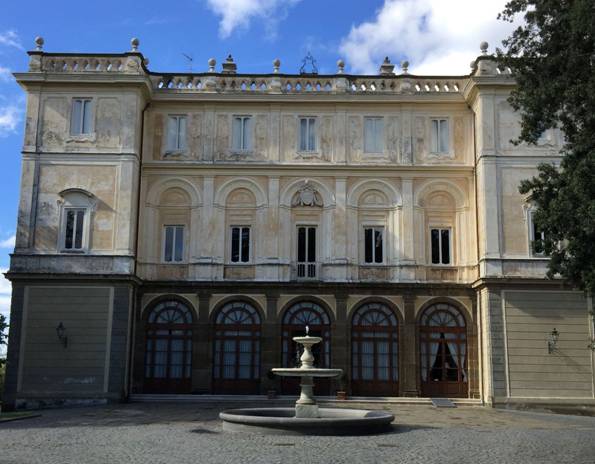A Tale of Three Italies
A recent trip to Italy for a speaking engagement afforded me the opportunity to stay several nights at three different properties in three different cities…and in a way, three different eras!
While documenting a travelogue for other hoteliers might be of some interest, the learning and applicability to hoteliers around the world is the focus here.
After landing in Bologna, the Grand Hotel Rimini on the Adriatic Coast literally transported me back to La Dolce Vita as this property was a perennial hang out for Federico Fellini, the director of this classic 1960 Italian film. The property décor, with a few modern technical touches added in, looks unchanged from the 1950s. It’s a bit of a shock to someone used to the vanilla, made-in-China-décor of today’s typical North American resort or any newly constructed chain address.
Everything about the property (108 rooms) says grandeur insofar as size and personality. Of course, we’re dealing with a property that is over a hundred years old, so one expects an over-the-top approach of the decadent imperial era: 14’ ceilings in guestrooms; 15’ wide corridors, a lobby large enough for an Italian opera, and lavish patios and gardens.
Yet, despite the aging of the physical product, the most important guestroom requirement was nevertheless to deliver a good night’s rest. In this respect, the hotel delivered: mattresses were new, sheets of exceptional quality, pillows soft and all amid pure silence.
Even with this impressive hard and soft goods display, however, the lasting impression was staffing excellence. In the face of limited speaking abilities in the native tongue, the team worked hard to respond to our needs without any sense of delay or miscommunication.
As an example, my wife and I arrived on property at an awkward time – an hour before the restaurant opened for dinner (which was 8pm as is common for Mediterranean cultures). Sidling up at the bar, we told the waitress we just wanted some food. Without looking at the menu, she immediately transformed a bar table into a dining facility, with a fresh tablecloth, linen napkins, a floral display, bread basket, cutlery and china. Next, she poured us glasses of Prosecco, all better asking presenting the full dinner menu. How can you resist this level of unanticipated service?
 Next was the Relais Villa Armena, a Small Luxury Hotels of the World establishment, located in Buonconvento, Tuscany. What a contrast! Everything at Villa Armena was like living in a jewel box, especially given that there were only ten guestrooms. While the Grand Hotel Rimini was quintessentially Old World; Villa Armena was classically-modern, a total rebuild of a farmhouse completed only a few years ago.
Next was the Relais Villa Armena, a Small Luxury Hotels of the World establishment, located in Buonconvento, Tuscany. What a contrast! Everything at Villa Armena was like living in a jewel box, especially given that there were only ten guestrooms. While the Grand Hotel Rimini was quintessentially Old World; Villa Armena was classically-modern, a total rebuild of a farmhouse completed only a few years ago.
Interestingly, this was a wholly family affair: design, construction and management all under the same roof. The feeling here is one of intimacy and a close relationship between the guest and owner. I was impressed with the approach insofar as understanding guests’ needs and a palpable gusto for the art of hospitality.
For an example, while we were in Tuscany and undoubtedly expecting a wide selection of great local wines, Villa Armena went one step further, offering wines off the list based upon a personal consultation. Then the next day, without asking, wines were served that extended the previous day’s knowledge and experience. To my surprise, the bottle labels were removed, pressed and given to me at checkout as a memento.
All of this was expertly and personally handled by the patron (mama) of the general manager (son), as she managed the entirety of the F&B experience. The family aspect coupled with professionalism was endearing and gave a genuine authenticity to the hotel experience. Moreover, having this proximity to the ownership made me feel as though my stay with them was of the utmost importance.
Las t came the Park Hotel Villa Grazioli (another Small Luxury Hotel) located in Frascati, a Roman suburb, is more museum than hotel. Built in 1580 as a cardinal’s residence, the property embraces its culture and history in every aspect. The principal rooms (62 in total: 20 in the villa, 42 in adjoining buildings) are large and laden in elaborate Renaissance-themed frescos, bringing a quaint sense of place to the experience.
t came the Park Hotel Villa Grazioli (another Small Luxury Hotel) located in Frascati, a Roman suburb, is more museum than hotel. Built in 1580 as a cardinal’s residence, the property embraces its culture and history in every aspect. The principal rooms (62 in total: 20 in the villa, 42 in adjoining buildings) are large and laden in elaborate Renaissance-themed frescos, bringing a quaint sense of place to the experience.
Common with the other two properties is the overriding concept of service excellence. The staff members were just finishing the cleanup of a full-house wedding when we arrived, and yet they were gracious insofar as giving us a full tour of the facilities, even as the moderately inebriated celebration remnants were leaving. This included a brief tour of the common rooms and an explanation for why the site was chosen by the original architects – a completely unobstructed and breathtaking view of St. Peter’s Cathedral some eight miles away.
Food and beverage, again, was superb (when isn’t it in Italy?). Despite this ancient setting, though, the menu presentation was unorthodox, served on glass plates and as exceptional as anything in a chic modern restaurant. For instance, the lemon gelato with vodka dessert was served in a champagne flute with the consistency of a milkshake, made only as ordered from egg whites, fresh lemons and, of course, ample quantities of Absolut.
Conclusion: No matter what size, no matter the geographic location and no matter the property’s age, service is always the critical determining factor in a guest’s evaluation. After all, you remember people over objects ten times out of ten. Additionally, you cannot separate food and beverage from the hotel experience. This is especially important when traveling in a foreign country where it’s a tad intimidating to venture beyond the hotel grounds for a nosh when all the roads are labyrinthine and the signage is in another language.
(Article by Larry Mogelonsky, published on November 20, 2015 in Hotels Magazine)




